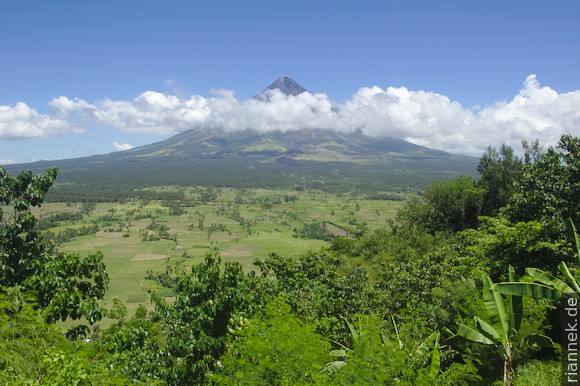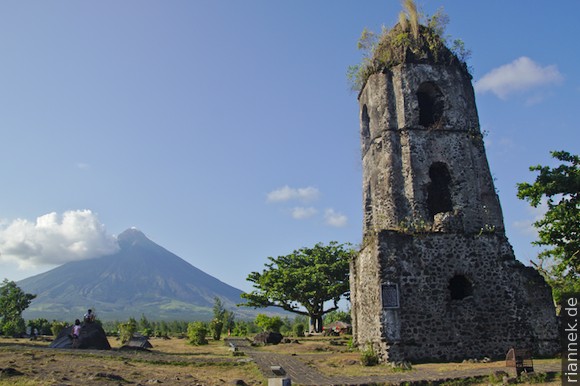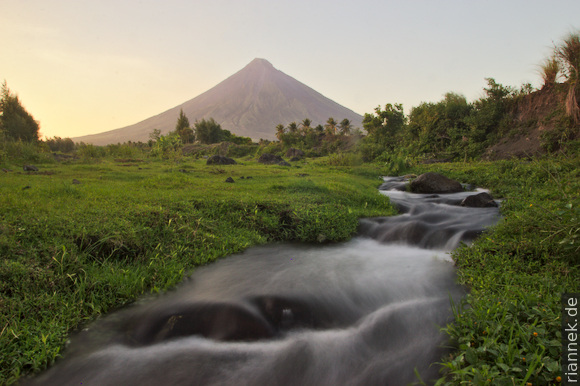
The stratovolcano Mayon on the island of Luzon (Philippines) is one of the most beautiful volcanoes in the world — if not the most beautiful, according to some. The slopes of the perfect volcanic cone get steeper and steeper towards the top. It is located in Albay province on the long and narrow peninsula of Bicol, which hangs like a monkey’s tail from the rest of Luzon. At its foot is the town of Legazpi, a good base to head for various viewpoints.

Beautiful views of the volcano are offered by Legazpi Boulevard, which leads south along the coast from the Embarcadero shopping centre at the harbour. The further you follow the road, the better the view. My best photos are from a hill that lies in a water protection area fenced off with barbed wire; the residents of the small huts showed me the way.

A good, but somewhat overrated view of the volcano is from Lignon Hill, which is just behind the airport. It is full of small tourist attractions like ziplines and unfortunately it is impossible to get a good photo of the volcano without a zipline cable hanging in the foreground.

One of the landmarks of the region is the ruined church of Cagsawa, a short jeepney ride from Legazpi. Apart from the church tower, there are only remains of walls since it was destroyed by a devastating eruption with pyroclastic flows and lahars in 1814. Hundreds of people who had taken refuge in the church perished in it. Whether they lost their faith in the process is not known, but in any case, faith is as strong as ever in the Philippines today. Photos of the church ruins often have a flair of loneliness, which does not correspond at all with reality. I was there both early in the morning and late in the afternoon, both times the church was swarming with people with selfie sticks…

Photographers like to follow the stream upwards (at the church it is enclosed in concrete walls, a little upstream two streams flow together, simply follow the slightly larger one to the right) for beautiful motifs with the stream and the volcano.

In Daraga, a suburb of Legazpi, there is a baroque colonial church on a hill, with a good view of Mayon from the stairs in front of the white portal. This is on the east side, so you should pass by in the morning.

A wonderful foreground for a picture of Mayon is the small artificial Lake Gabawan, about 2 km south of Daraga or 2.5 km southwest of the Albay district in Legazpi. If you want to visit it, you should memorise the way on Google Maps or better have a GPS with you: It is easy to reach by motorbike taxi, as long as you show the driver the way. You will hardly find a driver who knows this lake. Unfortunately, I had bad luck with the light, several times I was there at sunrise, but again and again the mountain was initially hidden in clouds.

I really like the relatively unknown Quitinday Green Hills, a typical tropical karst landscape (cone karst). They look similar to the famous Chocolate Hills on Bohol, only greener and with the huge cone of Mayon towering in the background. To reach them, take a jeepney to Camalig and from there a motorbike will take you to your destination in about 20 minutes.

Not far from Legazpi, but on the other side of the peninsula, is Donsol. This place is famous for the huge, completely peaceful whale sharks that can be seen off the coast almost every day from February to May. At more than 10 m long, it is the largest shark and the largest fish, but it only eats plankton and small fish. Boat trips for snorkelling are organised from the Visitor Centre in the mornings. It is quite impressive to swim next to one of the huge creatures. I am lucky, we are a relatively small group on the boat, which is a bit more expensive, but much nicer. As soon as a whale shark is spotted, the captain brings the boat into position and we jump into the water. Most of the time it swims straight towards us before we follow it for a bit. Back into the boat we set off in search of the next encounter. Unfortunately, the visibility is often limited, it varies between 2 and 20 metres and sometimes you can only see a small section of the animal. But that’s because of all the plankton that the river washes into the sea, and that’s the reason why the animals are here. And sometimes we find a shark in a spot with good visibility.